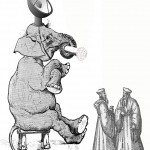My science career was in social psychology. It’s a field full of individuals, but a common motivation I found I shared with many of my colleagues is a serious understanding and critique of stereotypes, prejudice and discrimination. These topics are the core of the field, and one of our best tales of success in applying the scientific method to issues of serious social concern.
The other biggest areas of study in social psychology are attitudes and values (people’s beliefs) and personality (understanding people’s other consistent motivations and behaviors). These again demonstrate the field’s interest in understanding individuals in depth.
At some point, my writing will really benefit from this training and background. Right now, as a newly minted intern at a daily newspaper, my tendencies to seek out a deep understanding of my sources and subjects are crashing up against the structural demands of daily correspondence.
I came to this realization after two recent stories became overly difficult and stressful. I sought outside perspective, first from colleagues and my formal instructors and then from a couple of recent alumni from our program.
The “a-ha” moment came when one of these advisors suggested that I dial back my expectations on an upcoming assignment. I’ll soon be publishing with mongabay.com on research on hunting patterns in indigenous communities on the Guyana/Brazil border.
“You won’t be able to drive up to Stanford and spend an hour with this biologist. It just won’t work,” said one of my advisors.
On the one hand, it felt good to be understood so completely that this advisor could have guessed that this was my initial idea. On the other hand, I was caught up short to learn how completely my intended preparations were so far out of line with the actual physical and time constraints that come along with a 500 word article with a relatively short deadline.
It just won’t work–duh. But I struggle with feeling all right with any other approach. How could anything less actually convey the full picture without resorting to stereotypes?
My struggle will be to limit the information I gather to just that necessary to tell a story reasonably completely, without coming up drastically short in my own understanding. I need to feel a certain reassurance that the picture I am painting is relatively true to an individual’s life and experience, but I am learning that even my usual lengthy interview style will never truly satisfy that need for a deep, complete understanding that my psychological training has driven me to seek.
Several of my advisors on this issue suggested some key things to understand about local newspaper readers.
- “Put yourself in the reader’s brain,” it was suggested.
I learned that a lot of information habits that I have long sought to train out of myself are alive and well among many of my readers.
- Topics I find inherently fascinating, and will excitedly pursue in depth, may not exactly resonate with our usual audience.
- “They like to read about each other. Stuff about sports, dead people, inspiring portraits, and crime reliably become the biggest hits for the paper,” several advisors have suggested.
- I could learn a lot, another advisor suggested, by reading widely on topics that currently hold no interest for me at all. If, for instance, I spent an hour following the news about cricket, I could learn much from what sticks with me after I’ve read. Which stories do I read through to the end? How did that writer accomplish these impacts in the limited space and time given?
- The sustained attention I have cultivated through scholarship and meditation training may not be so widely shared as I would like.
- “It really has to be an in-and-out situation. You have maybe 2 to 3 minutes of their eyes.” Sometimes that means to “leave them hungry for more,” one advisor suggested.
- “People hate jumps from the first part of an article to another part of the paper. Online, they are not too fond of next page button,” was the advice given.
- As a writer, I want to match the style of my paper, because the style has developed to maximize news interest and impact with it’s particular audience. Over time, I will learn to put my story together somewhat ahead of time, regardless of how much this rankles my ideals of treating every story as unique.
- One advisor addressed my concerns like this: “You’re not guiding the story, but writing a lead paragraph, knowing what to look for in a first good quote, knowing what background needs to be included but can wait till later, learning about what happens next in the story, and how will I stop or wrap up the story?”
- This will allow me to be in control of interviews and to limit the time and information crunch as the afternoon arrives carrying my deadline. Besides, a real danger of a backlash exists in being overly indulgent.
- “When you spend 30-60 minutes with a person, they expect to see everything you talked about in print,” an advisor helpfully pointed out. “They might contact you with reactions from bewildered to angry because everything didn’t show up!”
- The final bit of strategy could equally apply to myself as well as handling these interview subjects who may never be satisfied with how they appear in print, ignoring the limits of our genre, “lower their expectations.”
- “Say to your subjects, I’ve only got a couple of minutes, I’ll throw a couple of questions at you and then I’ve got to run.”
And, dear readers, I do indeed need to run now. Wish me luck in following this good advice and any other guidance you may care to share in your comments.








Comments are closed.